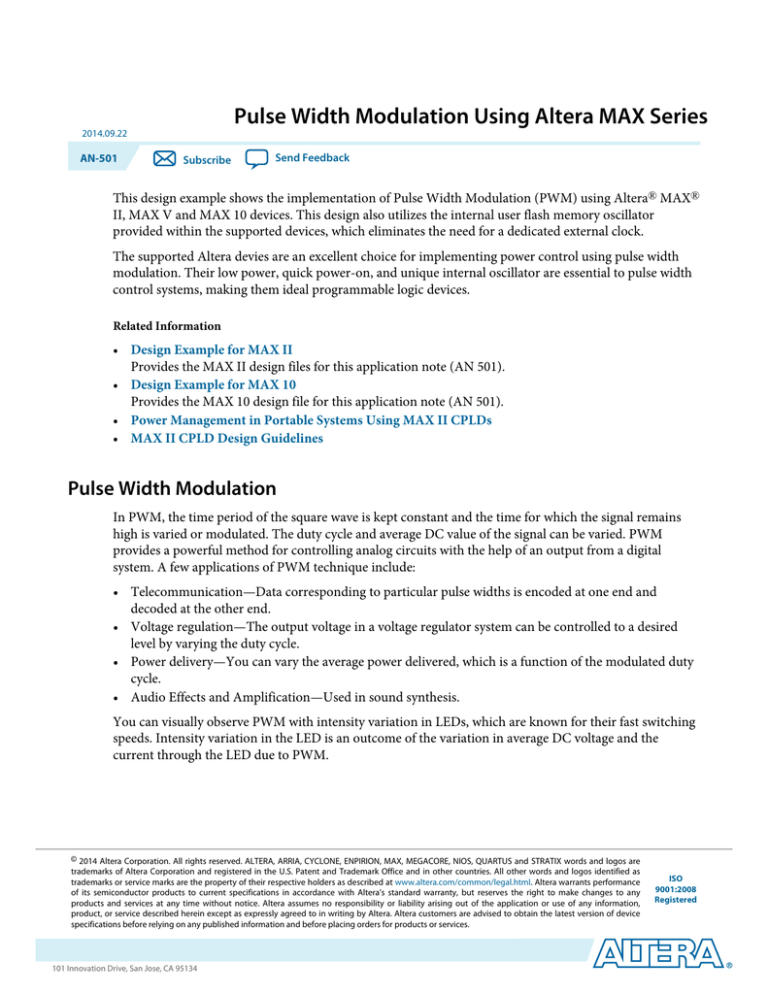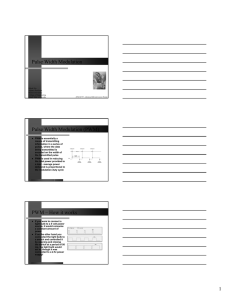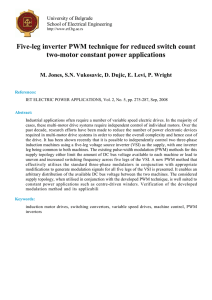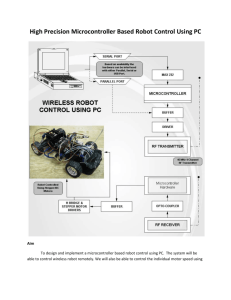
Pulse Width Modulation Using Altera MAX Series
2014.09.22
AN-501
Subscribe
Send Feedback
This design example shows the implementation of Pulse Width Modulation (PWM) using Altera® MAX®
II, MAX V and MAX 10 devices. This design also utilizes the internal user flash memory oscillator
provided within the supported devices, which eliminates the need for a dedicated external clock.
The supported Altera devies are an excellent choice for implementing power control using pulse width
modulation. Their low power, quick power-on, and unique internal oscillator are essential to pulse width
control systems, making them ideal programmable logic devices.
Related Information
• Design Example for MAX II
Provides the MAX II design files for this application note (AN 501).
• Design Example for MAX 10
Provides the MAX 10 design file for this application note (AN 501).
• Power Management in Portable Systems Using MAX II CPLDs
• MAX II CPLD Design Guidelines
Pulse Width Modulation
In PWM, the time period of the square wave is kept constant and the time for which the signal remains
high is varied or modulated. The duty cycle and average DC value of the signal can be varied. PWM
provides a powerful method for controlling analog circuits with the help of an output from a digital
system. A few applications of PWM technique include:
• Telecommunication—Data corresponding to particular pulse widths is encoded at one end and
decoded at the other end.
• Voltage regulation—The output voltage in a voltage regulator system can be controlled to a desired
level by varying the duty cycle.
• Power delivery—You can vary the average power delivered, which is a function of the modulated duty
cycle.
• Audio Effects and Amplification—Used in sound synthesis.
You can visually observe PWM with intensity variation in LEDs, which are known for their fast switching
speeds. Intensity variation in the LED is an outcome of the variation in average DC voltage and the
current through the LED due to PWM.
© 2014 Altera Corporation. All rights reserved. ALTERA, ARRIA, CYCLONE, ENPIRION, MAX, MEGACORE, NIOS, QUARTUS and STRATIX words and logos are
trademarks of Altera Corporation and registered in the U.S. Patent and Trademark Office and in other countries. All other words and logos identified as
trademarks or service marks are the property of their respective holders as described at www.altera.com/common/legal.html. Altera warrants performance
of its semiconductor products to current specifications in accordance with Altera's standard warranty, but reserves the right to make changes to any
products and services at any time without notice. Altera assumes no responsibility or liability arising out of the application or use of any information,
product, or service described herein except as expressly agreed to in writing by Altera. Altera customers are advised to obtain the latest version of device
specifications before relying on any published information and before placing orders for products or services.
www.altera.com
101 Innovation Drive, San Jose, CA 95134
ISO
9001:2008
Registered
2
AN-501
2014.09.22
PWM Using MAX II Devices
PWM Using MAX II Devices
The detailed description of the implementation is based on the MAX II devices. This application can also
be implemented in MAX V and MAX 10 devices.
The up and down input signals are used to vary the duty cycle of the output signal. The first module is
used to generate two clocks of different frequencies with the available internal user flash memory
oscillator in MAX II devices. The 4-bit output signal from the DUTY_CYCLE module has positive or
negative incrementation, depending on whether up or down is asserted. The second 4-bit output signal
COUNT (reference counter) is incremented continuously at the higher clock frequency generated in the first
module. This signal is compared to DUTY_CYCLE at the same frequency in the second module. The result of
the comparison, which is a single bit, is assigned to the final output signal PWM.
Figure 1: Implementation of Pulse Width Modulation Using a MAX II Device
MAX II Device
DUTY_CYCLE
UP
DOWN
Clock and
Variable
Generation
Module
4
COUNT
Comparison
Module
Pulse Width
Modulated
Signal
4
The inputs to the PWM are comprised of up and down signals used to vary the duty cycle of the output
signal. The device uses two basic modules to realize the working of the PWM. All input and output signals
are of a single bit.
The 4-bit variable signal DUTY_CYCLE allows 16 different variations in the duty cycle of the output signal.
In this design implementation, input up has a higher priority over down. If both are high at the same
time, the output signal sees an increase in its duty cycle.
You can implement this design example with an EPM240, or any other MAX II devices, and observe
results by controlling the intensity of mono-color (red) LEDs and varying color shades of bi-color (red/
green) LEDs on the MDN-B2 demo board. Implement this design with the design example source code
and allocate the appropriate control and output lines to the GPIO lines of the MAX II device that are
connected to LEDs. The red LEDs are driven by the PWM output, which causes their intensities to vary. The
bi-color LEDs are driven by two mutually complementary signals: PWM and PWM_INV. The frequency of
operation causes the phenomenon of persistence of human vision. This creates a small spectrum of colors
involving the two individual colors of the bi-color LEDs, while their individual intensities are varied
corresponding to the PWM signal. You can operate two push-button switches on the demo board to
gradually create the small spectrum of colors. This also illustrates the change in the duty cycle of the
output signal because of the varied intensity of the single-color LED.
Altera Corporation
Pulse Width Modulation Using Altera MAX Series
Send Feedback
AN-501
2014.09.22
PWM Design Demonstration on MDN-B2 Demo Board
3
Figure 2: PWM Demo Arrangement on MDN-B2 Demo Board
up/down pwm
control
MAX II
Implementing
pwm
Output LEDs
Table 1: EPM240G Pin Assignment
Assign unused pins As input tri-stated in the Device and Pin Options dialog box in the Quartus II software prior
to compilation.
Signal
Pin
pwm
Pin 87
pwm1
Pin 71
pwm3
Pin 73
up
Pin 82
pwn_inv
Pin 88
pwm2
Pin 72
pwm4
Pin 74
dn
Pin 81
PWM Design Demonstration on MDN-B2 Demo Board
To demonstrate the design example on the MDN-B2 demo board, follow these steps:
1. Turn on the power to the demo board (using slide switch SW1).
2. Download the design to the MAX II device through the JTAG header JP5 on the demo board and a
conventional programming cable (ByteBlaster™ II or USB-Blaster™).
3. Keep SW4 on the demo board pressed before and during the start of the programming process. Once
complete, turn off the power and remove the JTAG connector.
4. Switch on the power to the demo board (using the slide switch SW1) and observe intensity variations
in red LEDs when the up and down (SW9/SW8) push buttons on the MDN-B2 demo board are
pushed.
5. Bi-color LED D7 indicates different combinations of red and green colors with varying PWM output.
Acknowledgments
Design example adapted for Altera MAX 10 FPGAs by:
Orchid Technologies Engineering and Consulting, Inc.
Pulse Width Modulation Using Altera MAX Series
Send Feedback
Altera Corporation
4
AN-501
2014.09.22
Document Revision History
Maynard, Massachusetts 01754
TEL: 978-461-2000
WEB: www.orchid-tech.com
EMAIL: info@orchid-tech.com
Document Revision History
Date
Version
September 2014
2014.09.22
December 2007
1.0
Altera Corporation
Changes
• Added MAX V and MAX 10 devices.
• Updated template.
• Restructured document.
Initial release.
Pulse Width Modulation Using Altera MAX Series
Send Feedback




